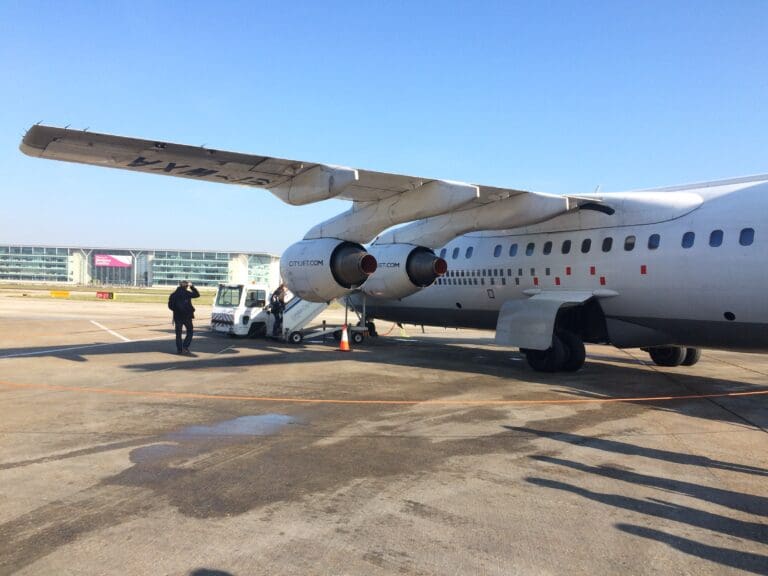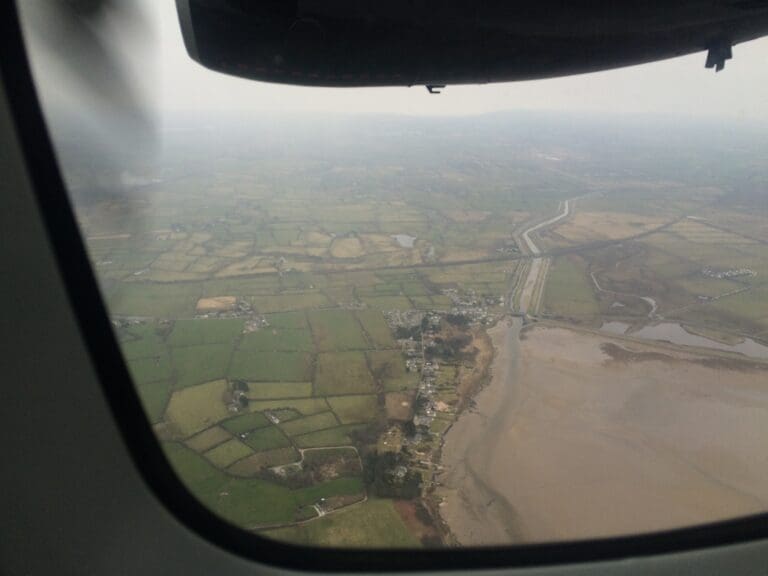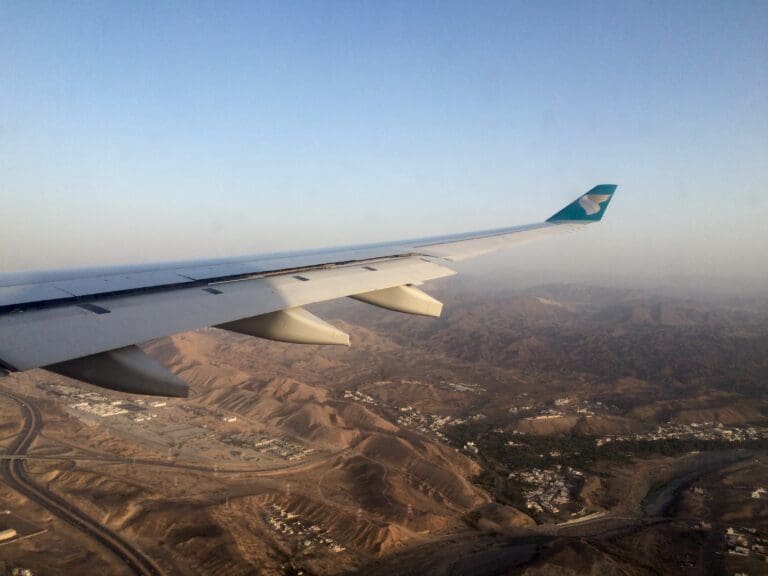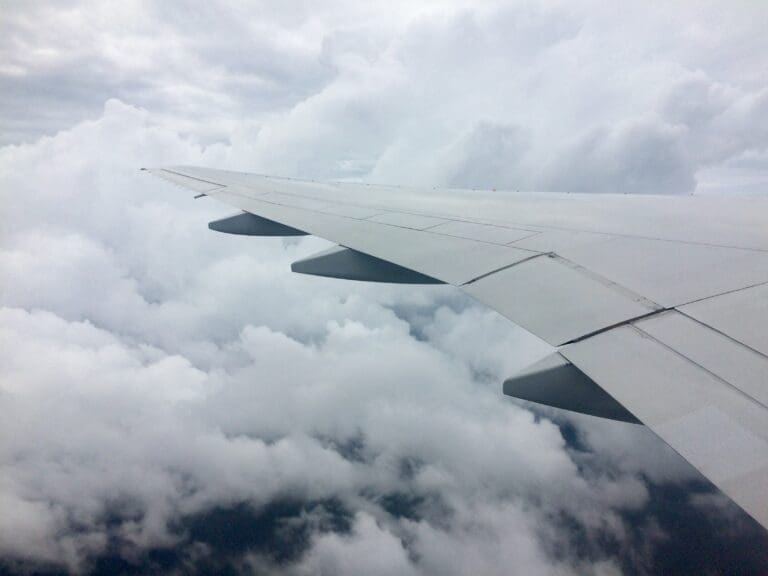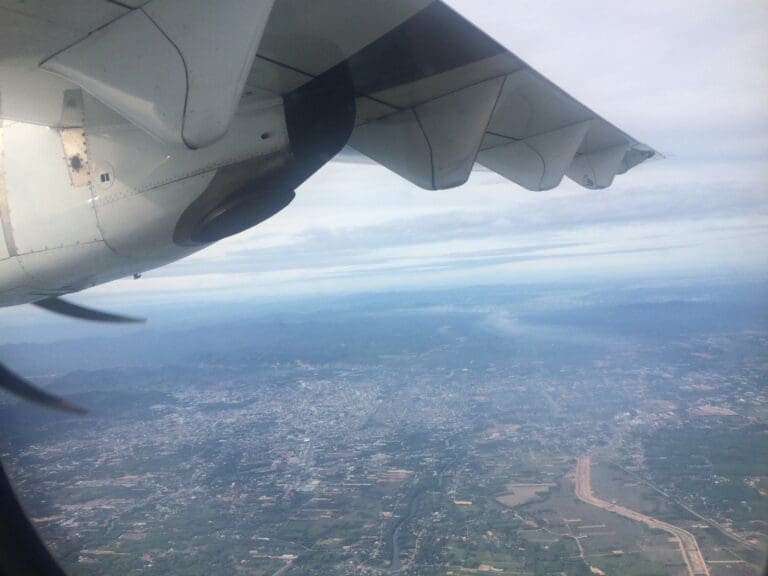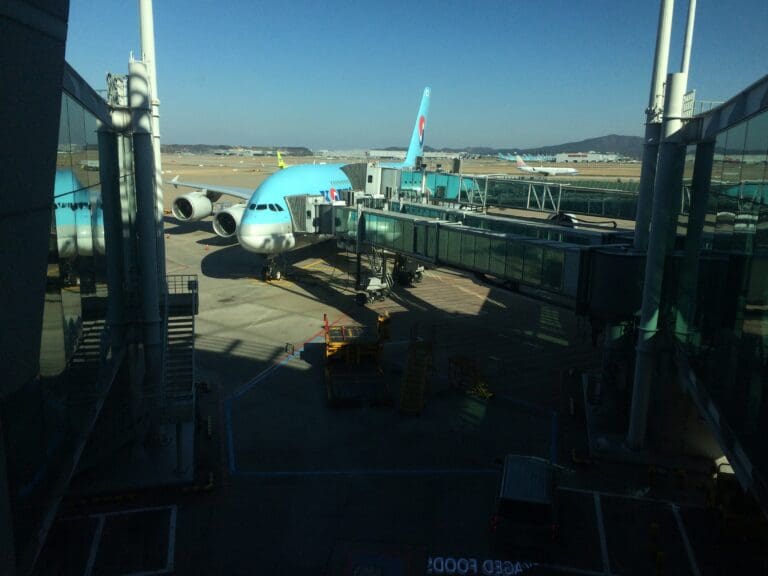What’s Belarus’ National Carrier Like? Astana to London Gatwick via Minsk with Belavia
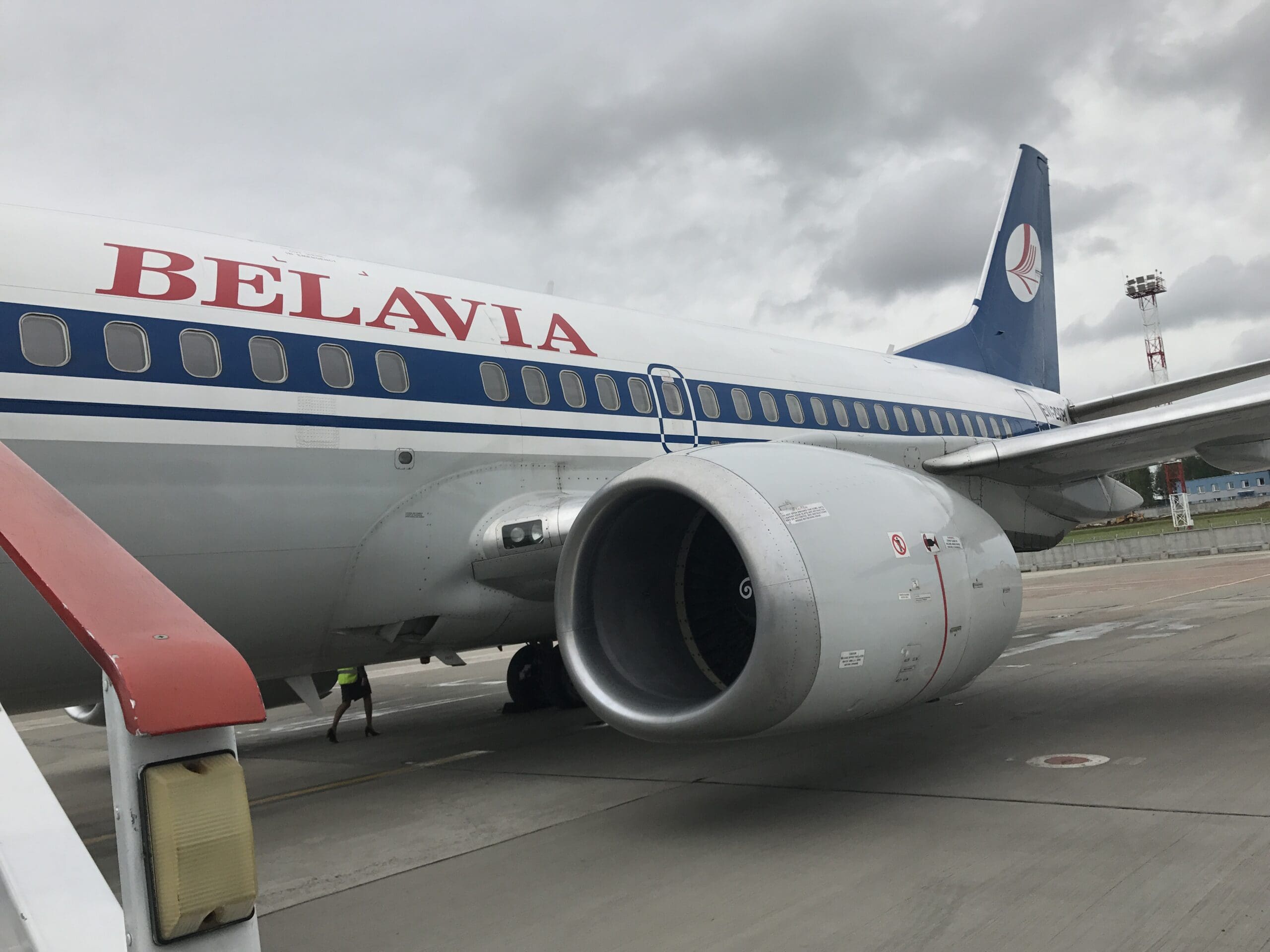
Background
Several days after leaving Seoul, I arrived at the approximate geographical midpoint of my narrowbody trek between Korea and the UK, Kazakhstan’s modern capital city, Astana. Whilst my trip until this point had been slightly indirect involving stops in Beijing, Xi’an and Almaty, several weeks before my trip I decided that I would fly a relatively direct one-stop route from Kazakhstan back to the UK.
A quick search revealed that Aeroflot, Belavia, LOT and Ukraine International Airlines all offered cheap and relatively cheap options via Moscow Sheremetyevo, Minsk, Warsaw and Kyiv Boryspil respectively. Of these, Ukraine International Airlines offered the cheapest itinerary; however, having already sampled the delights of Ukraine’s national carrier the previous year, I decided to skip this option. Turning to LOT, had I taken the trip several months earlier or later, this itinerary would have allowed me to fly on one of the airline’s oldest or newest aircraft, the Boeing 737-400 and Boeing 737 MAX 8, however, that day this routing would see me fly on two mundane Boeing 737-800s. Meanwhile, whilst Aeroflot offered decent journey times and the opportunity to fly on one of the carrier’s narrowbody and widebody jets, Russia’s national airline turned out to be the most expensive of the four carriers.
To more ‘normal’ passengers, Belavia was perhaps not an obvious option. The Belarusian national carrier did not offer the cheapest fare and with a connection time in Minsk of well over six hours, it was not the quickest option either. However, I had been intrigued by Belavia for quite some time. My interest in the airline began on sunny summer afternoons in the garden of my parent’s house, watching as their white and blue Boeing 737 Classics climbed as they headed eastwards away from Manchester. At that time, seeing as these older Boeing 737s were a little more common than in 2017, the real gems in Belavia’s fleet consisted of their older Soviet-era airliners such as Antonov An-24s and Tupolev Tu-154s, all of which have sadly now been withdrawn from service. Eager to finally sample the airline, I navigated myself to their modern-looking and easy-to-use website where I was soon presented with a single option for flights between Astana and London Gatwick via Minsk on my chosen departure day. These came with the price tag of $243.00, however, after selecting these, a further $53.30 was added in taxes and other fees thereby bringing the total to just under $300. Fortunately, I had no difficulty in purchasing my tickets and I soon received an email confirming my purchase with a receipt attached.
Whilst it was not possible to select seats whilst booking the flights, Belavia offers online check-in 24 hours before departure and I was pleased to find that this enabled me to select seats without any issue. Upon doing so, I received a pleasant surprise. Seeing as my flights had initially been scheduled to be operated by a Boeing 737-800 and an Embraer 195, upon selecting my seat for the second leg, rather than being presented with a seat map which showed the 2-2 configuration of the Embraer, this displayed a small 3-3 cabin indicating that the flight would be operated by a Boeing 737-500!
The Airline
Many may be unfamiliar with Belarus’ national carrier, however, Belavia aircraft can be spotted daily at many of Europe’s major airports. The airline was formed in March 1996 with a fleet of now rare Soviet-built aircraft such as the Ilyushin Il-86, Tupolev Tu-134 and Tupolev Tu-154. A couple of years later the Antonov An-24, Antonov An-26 and Yak 40 were also added to the airline’s fleet following the merger between Belavia and Minsk Avia. According to the airline’s website, during the late 1990s the airline operated international services to Beijing, Istanbul, Larnaca, London and Rome. Whilst the airline may no longer operate long haul services, over time Belavia’s route network underwent significant expansion and as of 2017 the airline flies to a respectable total of 57 destinations across Central Asia, Europe, the Middle East and North Africa.
As with many major passenger airlines across the former Soviet Union, Belavia underwent a process of fleet modernisation commencing with the delivery of their first Boeing 737 Classic in October 2003, a Boeing 737-500 that had previously served with Continental Airlines and Mekong Airlines. In total, fifteen Boeing 737 Classics were delivered to the airline, the latest delivery taking place in May 2014. These were joined by six Bombardier CRJs between 2007 and 2010, and in September 2012, the airline reached another milestone taking delivery of its first brand-new aircraft which came in the form of an Embraer 175 with another delivered the following month. Two slightly longer Embraer 195s were added in 2014 and in 2015 the airline introduced a new type to its fleet, the Boeing 737-800, taking delivery of two aircraft that had previously served with Air Berlin and TUIfly. Finally, in 2016 Belavia took delivery of three Boeing 737-800s directly from Boeing, all of which sport the airline’s new livery.
The Flight
As the sun started to come down over the steppe I stood with a crowd of Sunday shoppers of all ages outside Astana’s Asia Park Mall whilst repetitive audio advertisements aimed at waiting passengers blared out of speakers pointed directly towards the bus stop. As I waited, buses came and went, some old but most reasonably new and well-kept but there was no sign of the Number 12 bus that would take me back to the airport. As time passed I was becoming increasingly sceptical of whether I was at the right stop, even though my bus was listed on the poster inside the air-conditioned shelter.
Not wanting to walk much more in the summer heat I breathed a sigh of relief when eventually a bendy bus with the letters 12 and ‘airport’ displayed in Cyrillic lettering on the front of the bus slithered around the corner. Unsurprisingly, the bus was full and it took some time for the conductor to reach me, when he did I paid my 90 Tenge fare (around 16p) and relaxed knowing that I was on my way to the airport. A short while after I boarded, the number of passengers began to decrease and I was able to enjoy much of the journey from the comfort of a plastic seat. Whilst many visitors to Astana may take taxis to and from the airport, I would fully recommend those who lack large amounts of luggage to make the most of the city’s bus network. Even if you lack any Kazakh or Russian language skills, so long as you have a rough idea of where you’re headed and which bus to take, you shouldn’t encounter too many problems.
Once back at the airport, I headed to my large if not slightly basic hotel room at the airport’s hotel located on the ground floor of the domestic terminal. With plenty of time to go before my flight and feeling a little tired after my day exploring the Kazakh capital I had a three-hour nap before waking up, having a shower and packing my things. At 0155, I headed out of the domestic terminal and made the short walk to the airport’s brand-new international terminal. After passing through a basic security check, I arrived at the terminal’s relatively large check-in hall and wandered over to Belavia’s two check-in desks. With flights heading off to Amsterdam, Batumi, Frankfurt, Kyiv and Minsk, at that time in the morning the landside portion of the terminal was rather busy however this was bright, clean and modern. Seeing as Belavia’s check-in desks were a little quieter than those of other airlines, I was able to approach the desk after only a minute or so of waiting where I was immediately greeted by a friendly check-in agent. After tagging my bag and handing me two colourful Belavia boarding passes, I was free to head through to the terminal’s departure area.
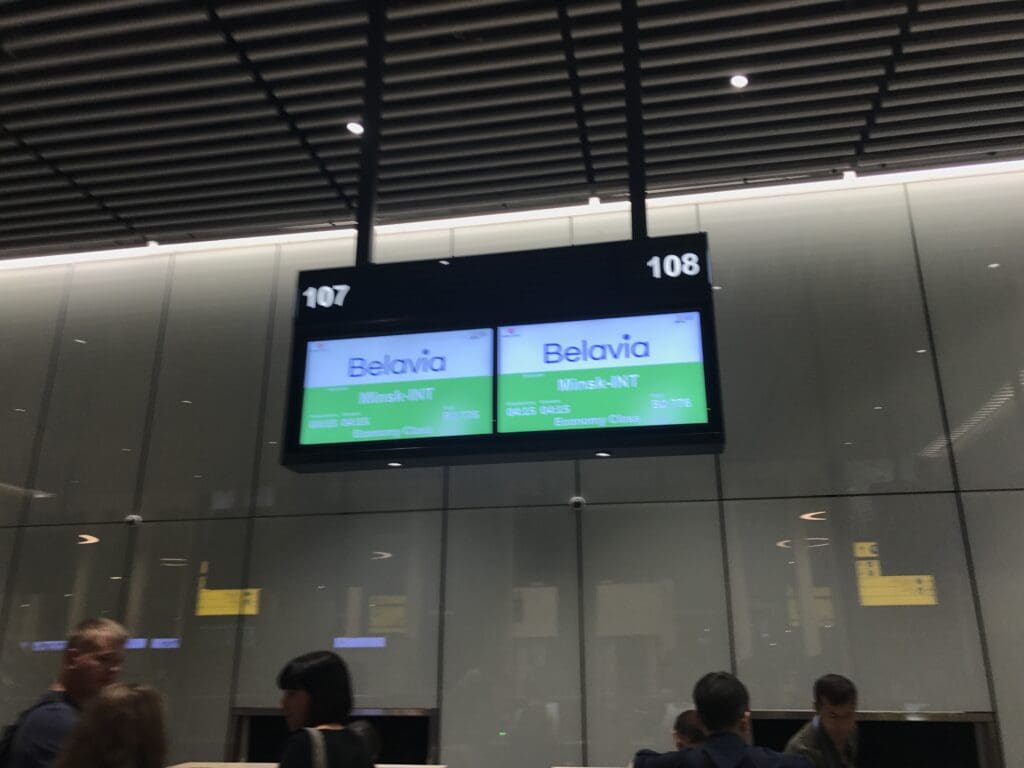
Heading up to the escalators to the terminal’s second floor, my next stop was immigration. Despite having read horror stories of officers in Almaty and Astana making requests for ‘additional fees’, my experience at the immigration booth was no different from anywhere else in the world. This involved a tough-looking official checking my passport and scanning this without a smile, giving me a good look up and down before stamping this with some force. As with immigration, security also lacked queues and was a stress-free experience, allowing me to enter the airside portion of the terminal around ten minutes after I had entered the check-in hall.
As I had expected, the airside departures area terminal was also fairly busy although this was clean and there were plenty of spots to sit down. For those not wanting to spend the duration of their wait sitting, this area is home to a large duty-free shop, a smaller souvenir shop selling mostly items related to the 2017 Astana Expo and a few relatively expensive cafes. Outside, a Bek Air Fokker 100 departed and a couple of Air Astana aircraft arrived from domestic destinations. The first sign of life at the international terminal came when KLM’s oldest Airbus A330 touched down after a short flight from Almaty as part of its Amsterdam-Almaty-Astana-Amsterdam route (although the airline cannot sell tickets for the Kazakh domestic leg of this journey). This aircraft was soon joined by another Airbus A330, with this operated by Lufthansa.
At 0320, a blue and white Boeing 737-800 sporting Belavia’s new livery touched down in Astana after its long journey over from Minsk. Seeing as the flight’s boarding time was scheduled for 0345, a very quick turnaround would have to be undertaken if this was to commence on time. At 0335, a long queue formed at the sliding doors that led to the jetways of the slightly older domestic terminal where the Belavia aircraft had come to a halt. As the flight’s scheduled boarding time came and went, there was still no sign that this would commence however, at 0400 I stood up and made my way over to this queue. After another five minutes of waiting the sliding doors that led to the gate opened and all piled through as if they were in a hurry to get onboard. As I passed through these doors, my boarding pass was scanned and torn before being checked again by a well-built security guard before I reached the aircraft’s L1 door.
The aircraft that would be undertaking the 1816-mile flight to Minsk would be Belavia’s then-latest delivery, a seven-month-old Boeing 737-8ZM, EW-457PA. Manufactured in Renton, this particular aircraft had first taken to the skies over Washington State in mid-December 2016 before being handed over to Belavia later that month. As with most Boeing 737 delivery flights to European carriers, the aircraft was flown over to Keflavík for a brief stop before continuing to its new home, Minsk. In the week leading up to my flight, the aircraft had flown around 34,000 miles during which it had visited Antalya, Ashgabat, Astana, Batumi, Burgas, Gomel, Heraklion, Izmir, Milan Bergamo, Milan Malpensa, Moscow Domodedovo, Rome Fiumicino, Thessaloniki, Tivat and Venice.
As I stepped into the forward galley, even though two flight attendants were standing there, I was greeted by nothing bar the familiar scent of warming airline food. From there I turned right into the aircraft’s modern cabin, home to 189 grey faux leather Pinnacle seats, each complete with a blue adjustable headrest, covered by a disposable antimacassar featuring the airline’s name. Aside from this, the aircraft appeared to have received some personalisation with the airline’s name and snowflake motif printed onto the walls at the front and rear of the cabin. Unlike the airline’s other aircraft (except for their CRJs), Belavia’s Boeing 737-800s lack a ‘real’ business class, instead featuring a Eurostyle business class with slightly better legroom, separated from the Economy cabin by a movable curtain.
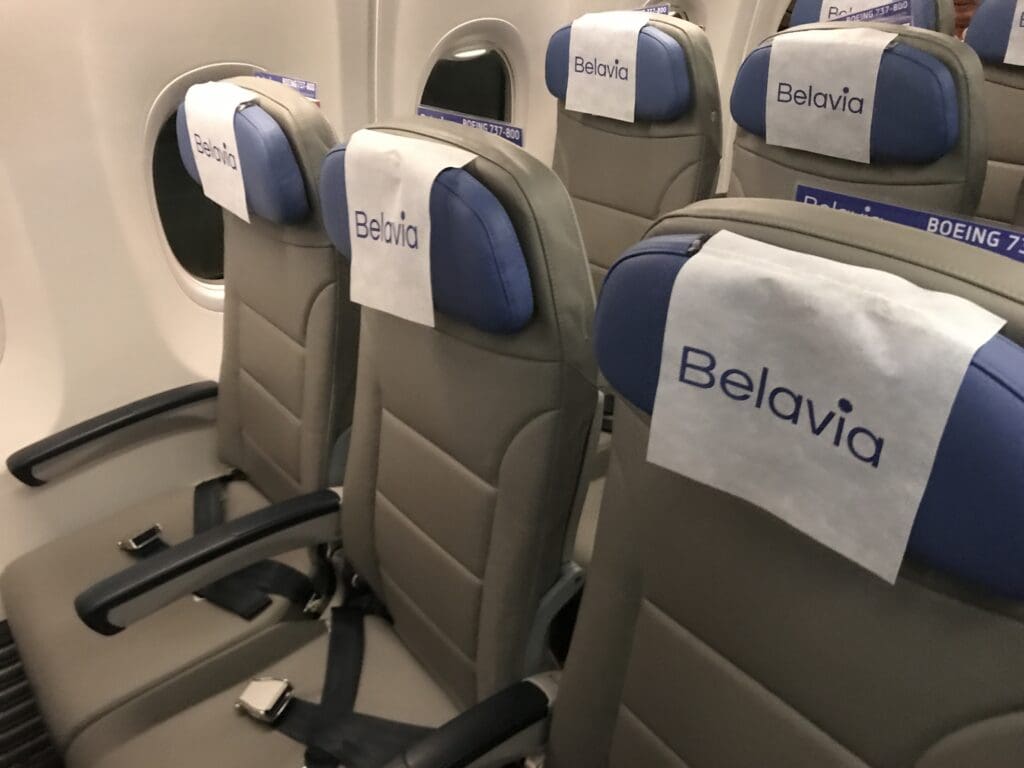
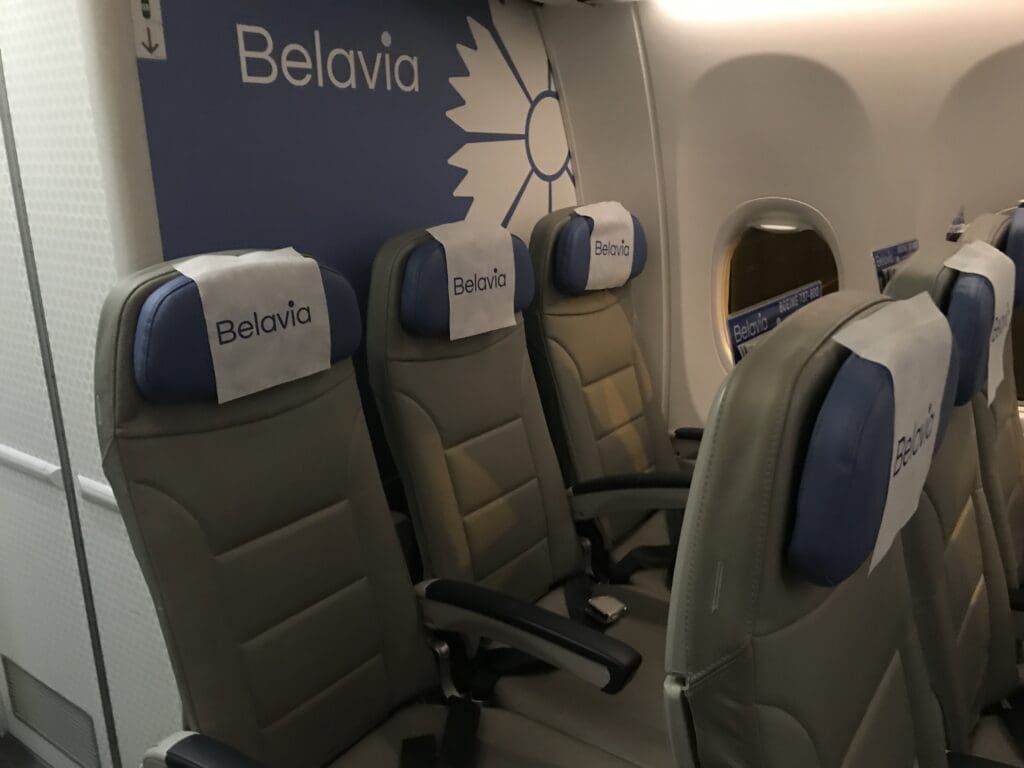
Seeing as the cabin was still relatively empty when I boarded, I soon made it to my seat at the rear of the aircraft. Upon sitting down, I found the seat itself to be slightly more comfortable than this appeared, the legroom on the other hand was very much akin to that provided by an LCC. This was unsurprising given the fact that, like Belavia, most LCCs operate the Boeing 737-800 with 189 seats. Turning to the contents of the literature compartment, this featured a copy of Belavia’s inflight OnAir magazine and a safety card.
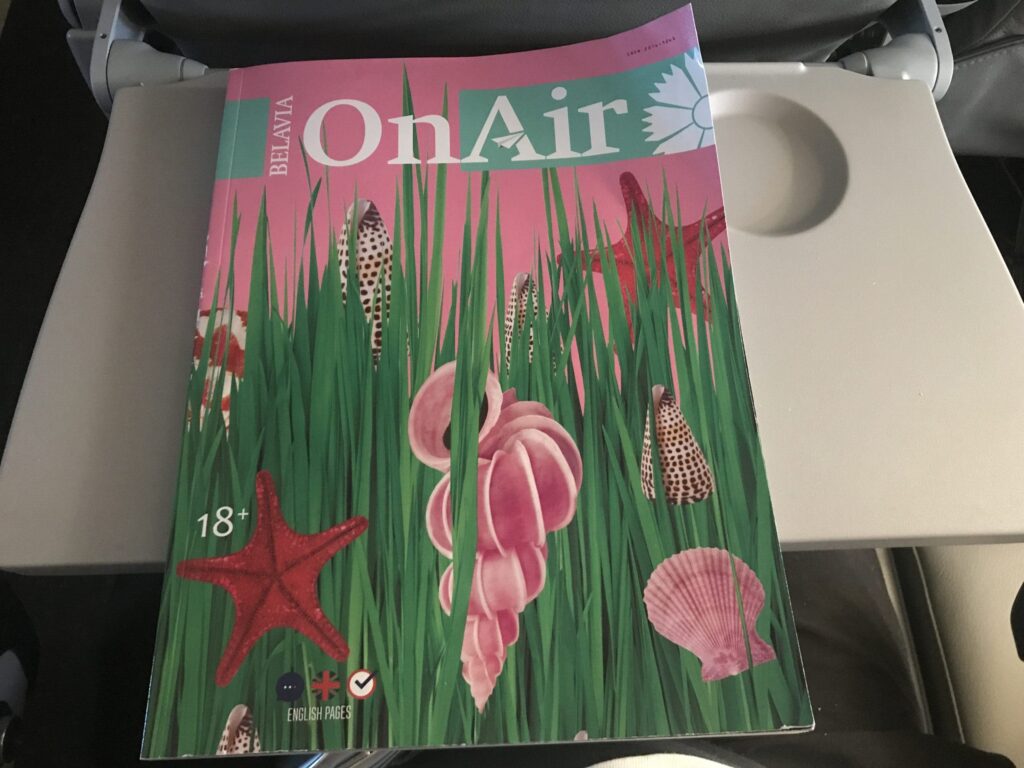
By 0420, all passengers had made it onto the aircraft and the flight appeared to be around 80% full with many families and leisure passengers onboard, the majority of whom appeared to hail from Belarus. Whilst a passenger had come to take the window seat, the middle seat remained empty which allowed for some extra space. Ten minutes after boarding had reached its conclusion, a sudden robotic-sounding American voice filled the cabin with the announcement ‘direct access message number one – this is a fasten seatbelt announcement’ whilst beneath the cabin, the cargo door could be heard and felt closing indicating the flight’s imminent departure. A minute or so later, the Captain performed a detailed bilingual welcome speech in a typically calm and collected tone whereby the flight’s flight time, distance and the weather enroute were mentioned before ending this with a word of thanks for flying with Belavia. This announcement was immediately followed by a typical welcome announcement made by the Purser and a manual safety demonstration.
At 0434, the Boeing 737 was pushed back from the gate and soon started its two CFM56 engines. Compared to the start-up of the two Rolls-Royce engines of the Fokker 100 that had taken me up to Astana the previous day, the Boeing’s start-up procedure seemed to be rather quiet and subdued. Once the tug was disconnected, the aircraft commenced its taxi to Runway 22 which seemed to be a little bumpy. At 0445, without any holding, the aircraft made a powerful takeoff before heading up into the reasonably clear skies. Seated in an aisle seat, whilst my views outside were largely limited, I caught glimpses of the streetlights of Astana below whilst above the skies were already brightening as the sun prepared to rise over the steppe. Turning my attention back inside, ten minutes after taking off, the faint blue mood lighting that had filled the cabin during departure was replaced by lights coming on at full blast which likely woke up all those light sleepers.
Upon reaching cruising altitude, the Captain made another announcement informing all of the aircraft’s cruising altitude and speed. Thirty minutes into the flight, the drinks service commenced which was soon followed by the breakfast service. At around 0545 Astana time I was handed a Belavia branded cardboard box containing plastic cutlery, hard bread and a chocolate chip muffin as well as a main dish consisting of boiled potatoes, meat and egg in a sealed foil dish. Whilst the quantity of food was reasonable, the main dish itself was probably one of the blandest inflight meals that I have tasted in living memory and was most certainly nothing to write home (or a trip report!) about. Around ten minutes after receiving the meal, another drinks round was made at which point I opted for a boiling hot tea. I should note that the two crew members who served me were both polite and incredibly friendly, leaving me with no complaints.
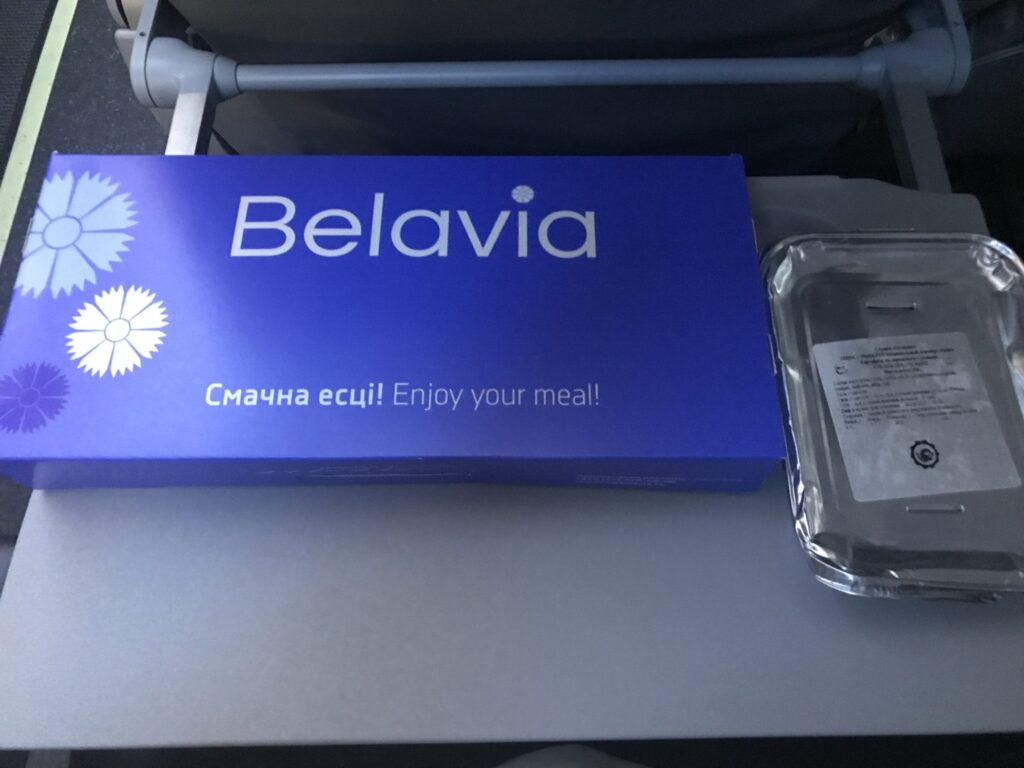
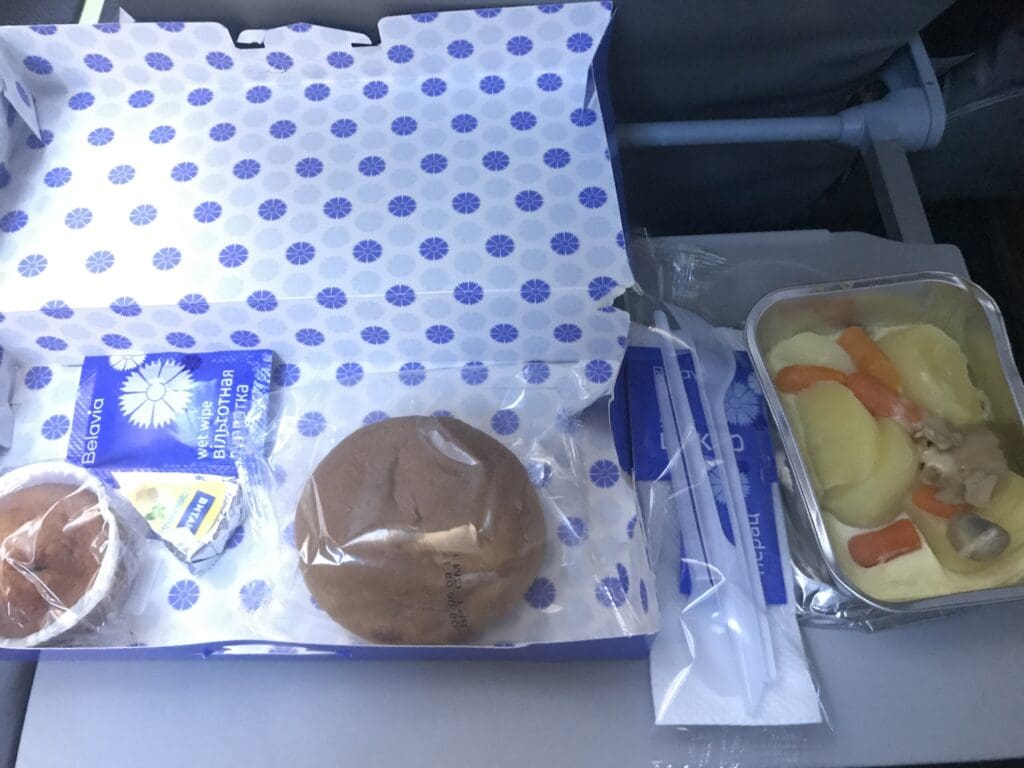
Outside, the red sun continued to rise as the aircraft headed west, with much of the flight taking place during the elongated dawn. By this stage, I was rather tired and so, like many onboard, I drifted off to sleep. Unfortunately, there seemed to be a near-constant queue of passengers waiting to use the two lavatories at the rear of the aircraft, with some opting to partake in conversation as they queued, thereby making getting any decent amount of sleep a little difficult. At 0740 Astana time, I woke up for good at which point daylight streamed into the cabin. That morning, after leaving Astana the aircraft had made its way northwestwards to the Russian border near Kostanay, before turning almost directly west once inside Russian airspace. This route took the aircraft over Samara and Tolyatti, south of Moscow and onwards to Bryansk before crossing into Belarusian airspace.
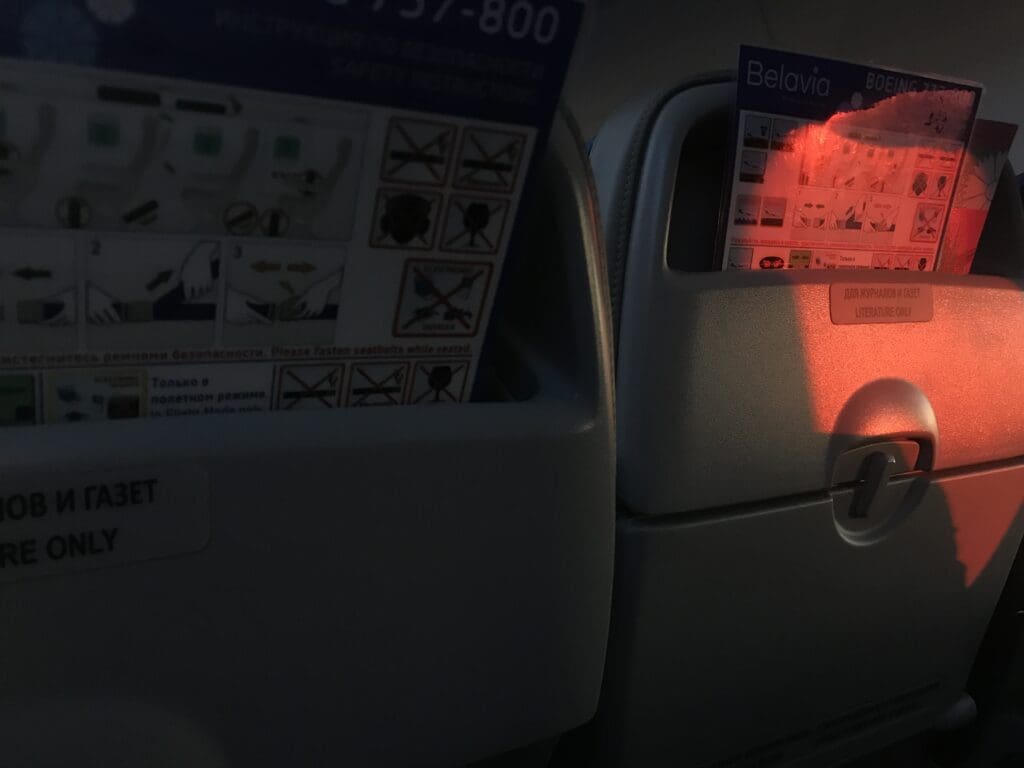
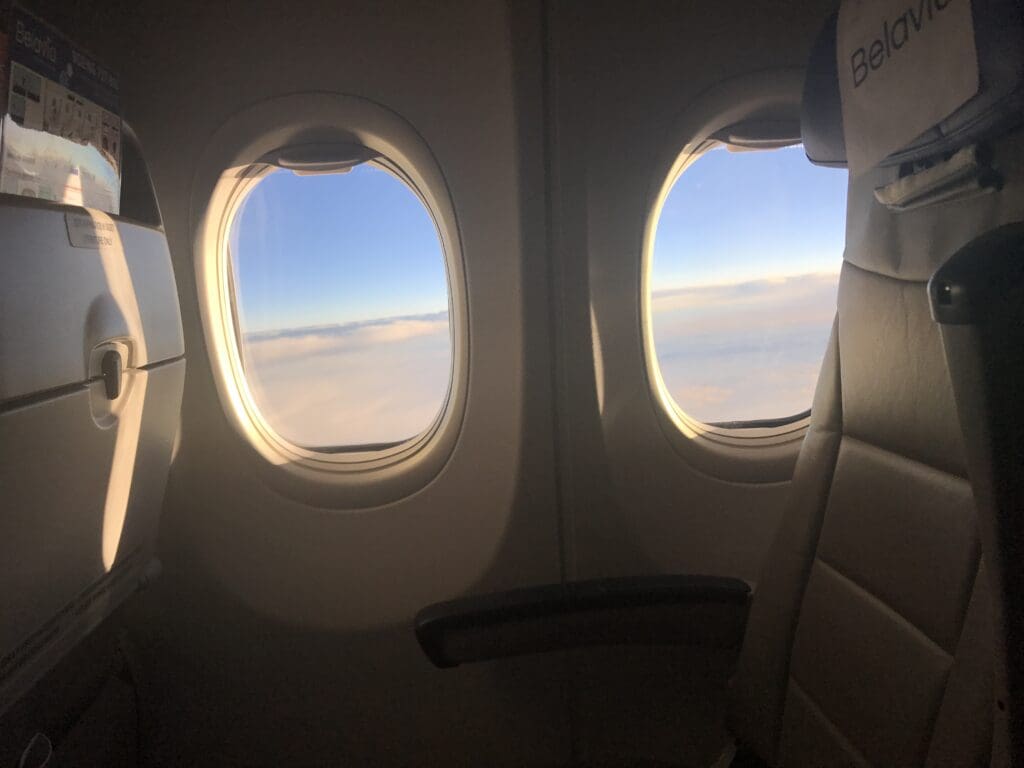
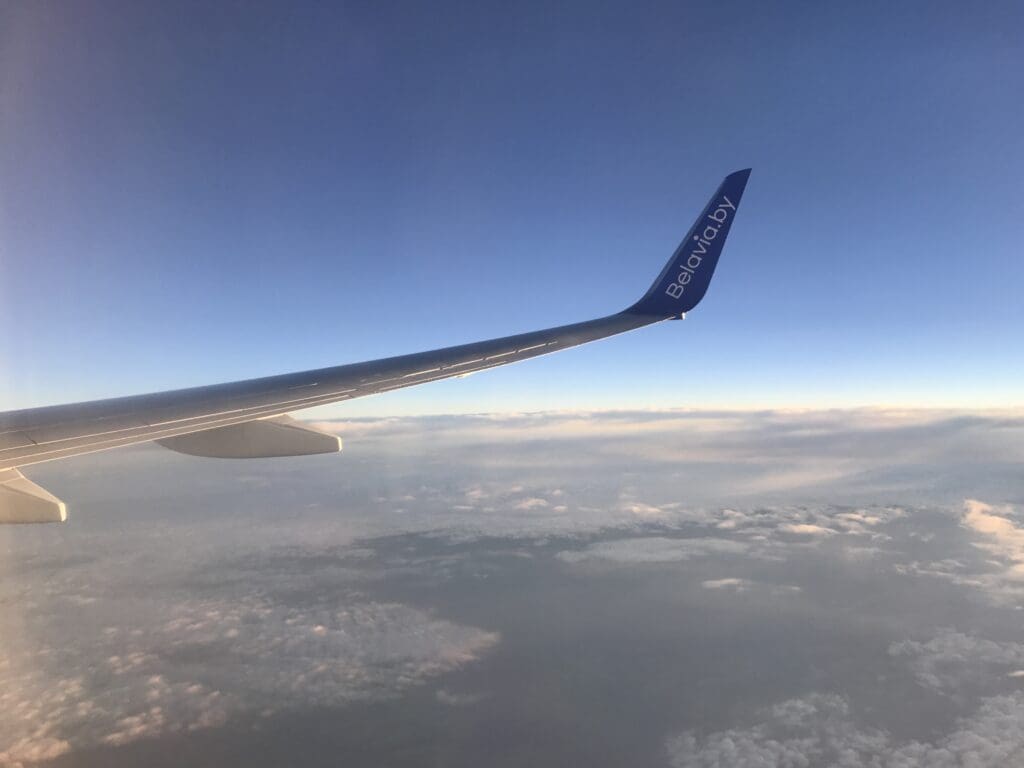
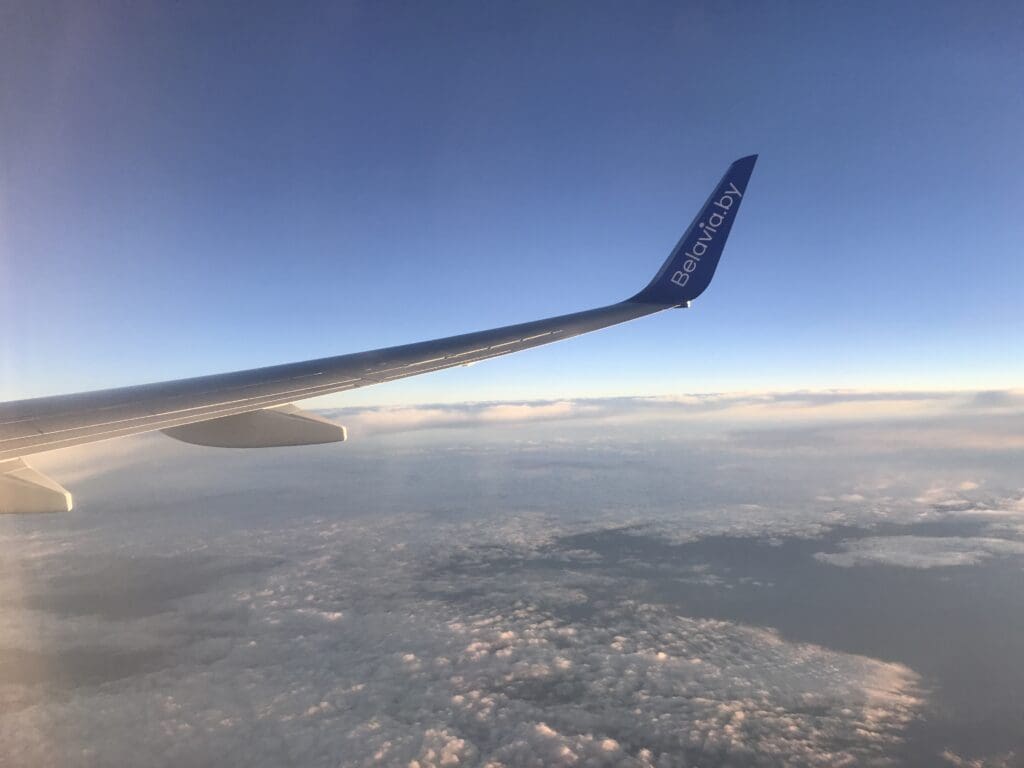
As the jet neared Belarus I paid a visit to one of the two lavatories and found this to be in a good, clean condition which was impressive considering how it appeared they had been used non-stop throughout the flight. At 0530 Minsk time, five minutes before the flight’s scheduled arrival time, the aircraft experienced the first patch of notable turbulence during the flight and several minutes later, a pre-arrival announcement was made and Belarusian arrival cards were handed out. After levelling off for several minutes, the aircraft continued its descent and the Captain performed their own pre-arrival announcement, informing passengers of Minsk’s cool summer weather and the flight’s delayed arrival time of 0610, 35 minutes behind schedule.
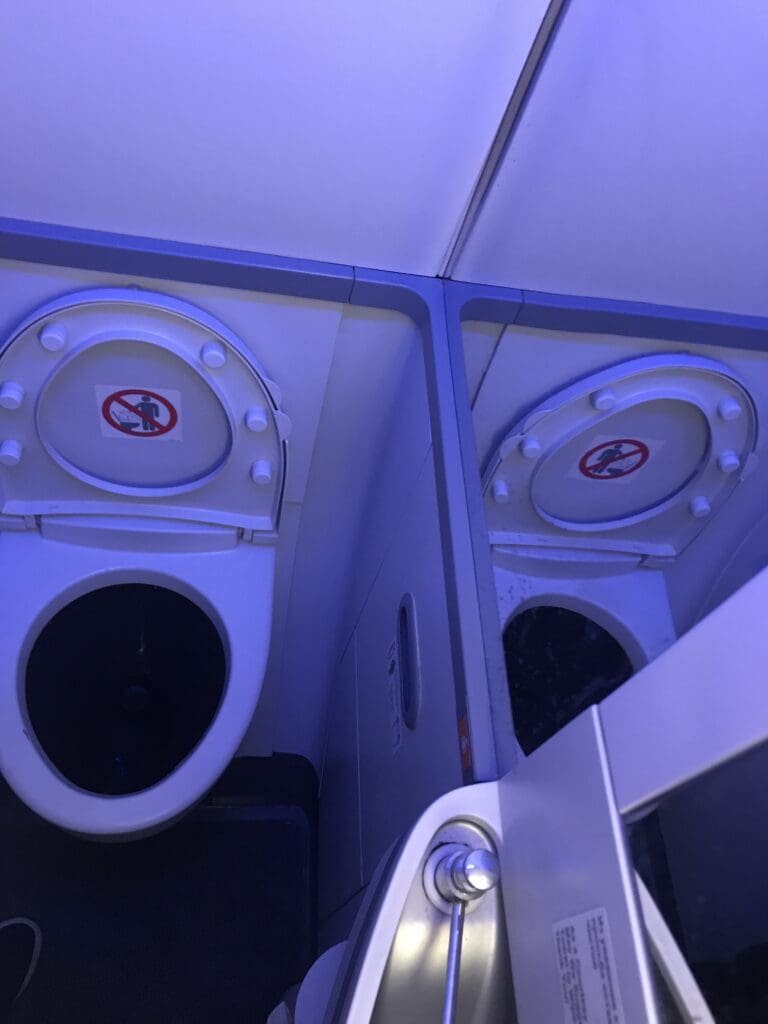
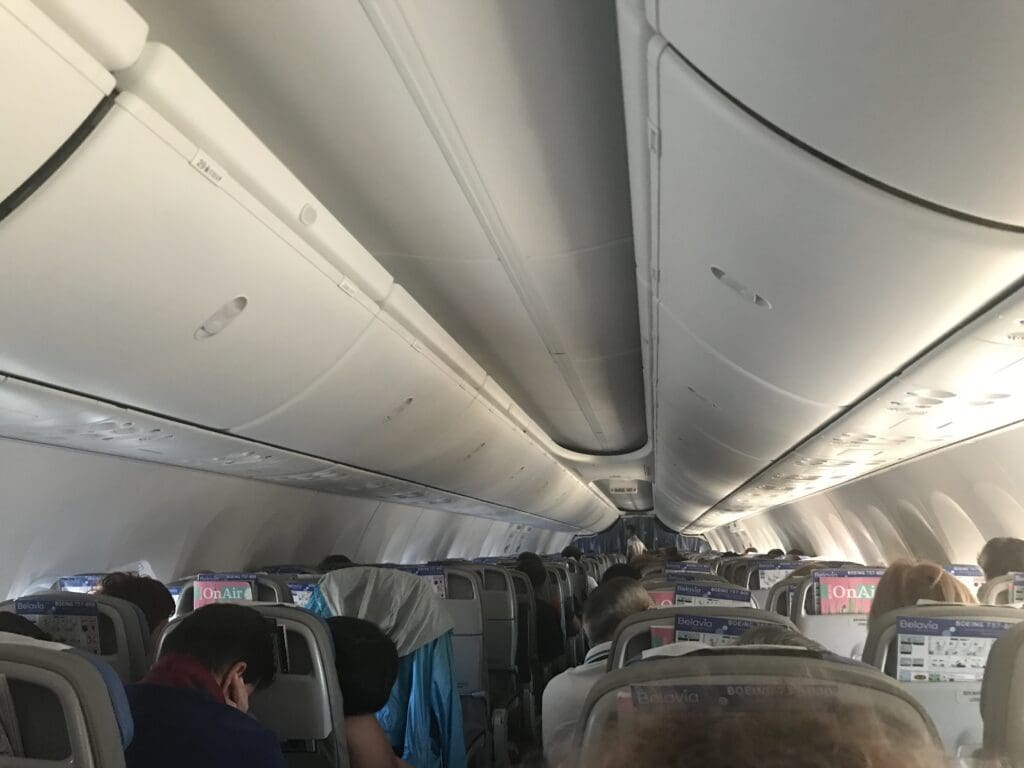
At 0550 the sudden sharp and slightly out-of-place tone of the automated direct access message played again as the aircraft sank further down over Belarus’ flat, green rural landscape. After undertaking several turns, the aircraft lined up for an approach to Runway 33 and the flaps and landing gear were extended. At 0603, 3H18 after leaving Astana, the aircraft returned to the ground with a barely noticeable bump which was followed by some rather harsh braking. As I looked right, a long line of Ilyushin Il-76s and Antonov An-12s, some active belonging to Transaviaexport and Ruby Star Cargo and some likely to never fly again zoomed past as the jet decelerated before Minsk’s grey space-age terminal popped into view.
As we slowed down the purser performed a speech welcoming all to Belarus and thanking passengers for flying with Belavia which was followed by a final speech from the captain. Following a short taxi, the aircraft pulled up to a jetway-less gate at the towering terminal and within a couple of minutes of the engines shutting down, disembarkation commenced through both the front and rear doors. Given my position at the rear of the aircraft, I ended up being one of the first passengers to step onto Belarusian soil after a fairly long flight over from Central Asia. Thankfully, passengers streamed out of the aircraft fairly quickly and so the bus soon pulled away from the aircraft commencing its short journey over to the arrivals area. Once off the bus, I walked under the ‘Welcome to Belarus!’ sign and into the slightly dated-looking terminal. Seeing as I was neither entering Belarus nor continuing onto Russia, I followed the signs for transit passengers which took me up a dark stairwell before bringing me out at a boarding pass and passport check. After passing this I headed through a security check and up another dimly lit staircase into the terminal’s airside departure area.
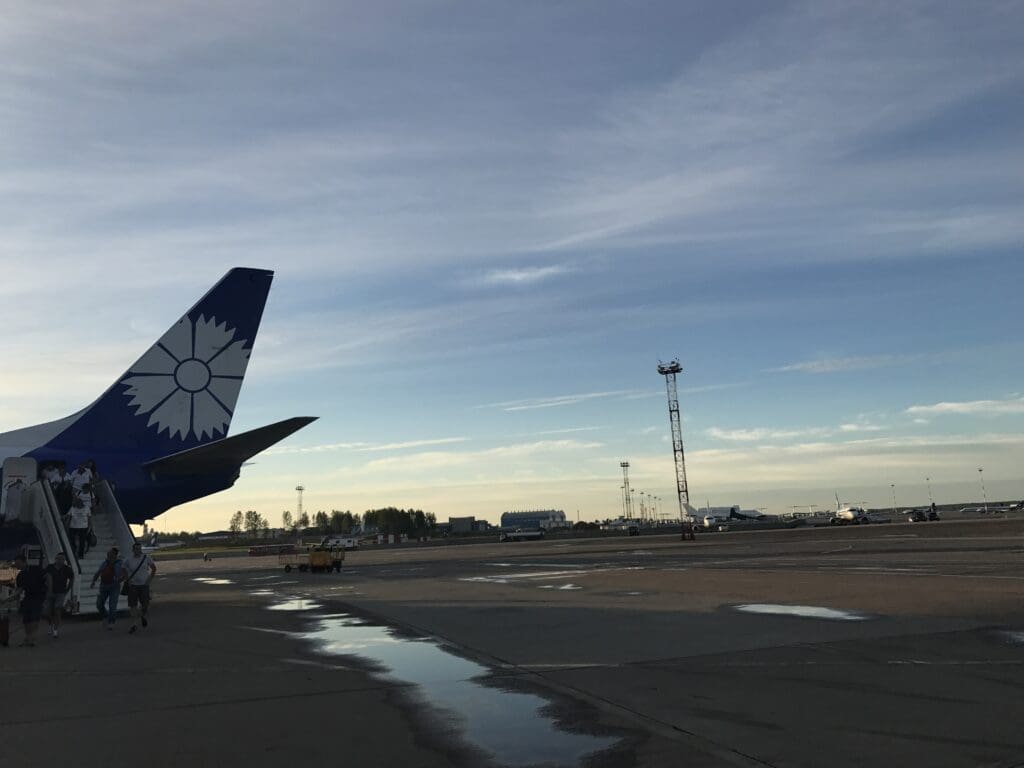

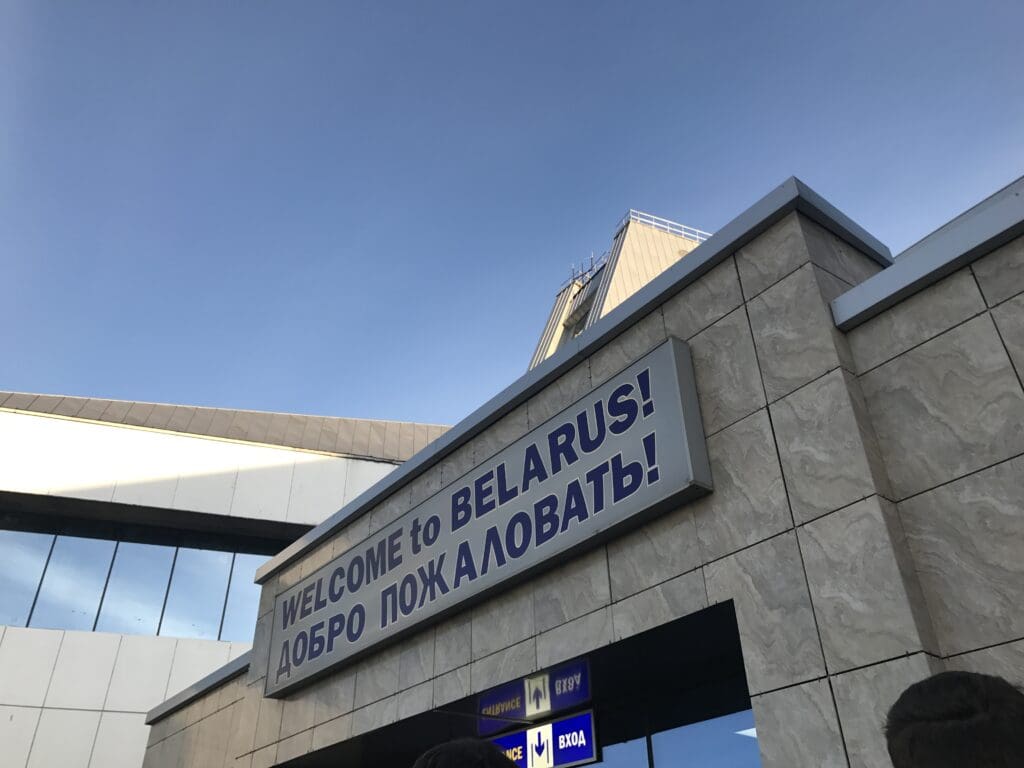
By the time I arrived in Belarus, I was incredibly tired. With six hours to pass in the terminal, I was not too enthusiastic at the prospect of spending my wait on one of the airport’s metal benches. Fortunately, I spotted signs for sleep boxes which come in the form of wooden huts and are located on the terminal’s top floor, just outside the business lounge. After paying the reasonable $20 fee to use these at the lounge’s bar area where I received a key to one of these and made my way towards my allocated hut. Inside, this was clean, nicely heated and comfortable and I soon drifted off for a solid three hours. Once I awoke, my allocated time was coming to an end, so I left the hut, handing my key back at the lounge’s bar before heading downstairs to the main area of the terminal.
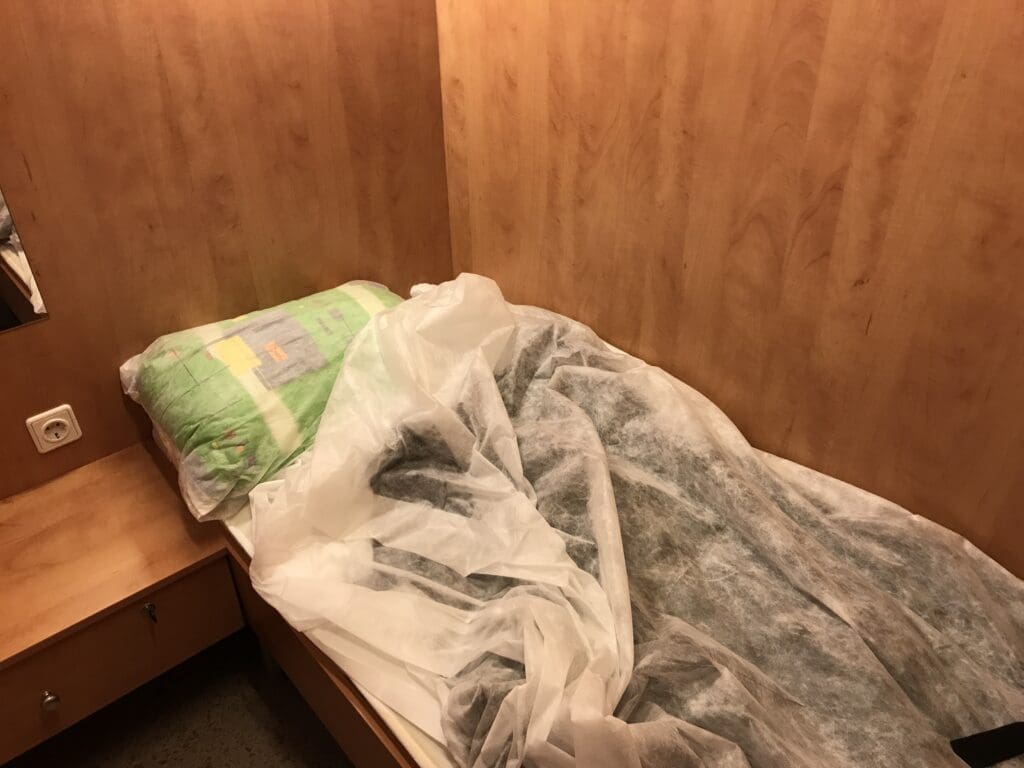
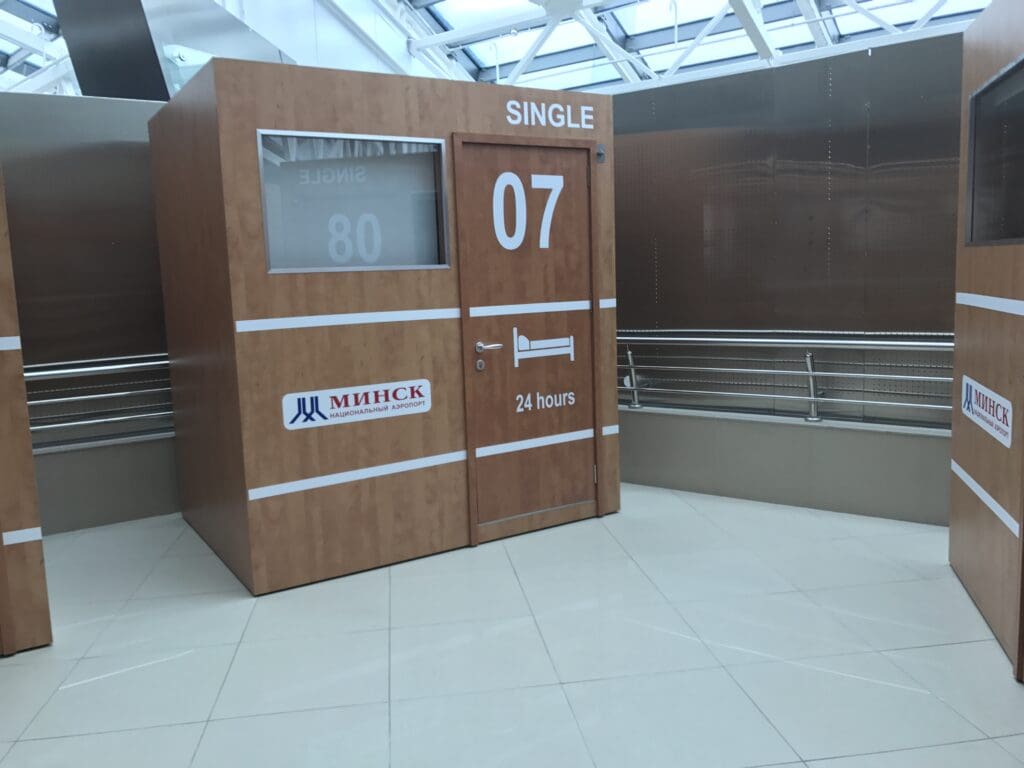
From the outside, Minsk National Airport bears some resemblance to a massive concrete spaceship, the sort that the optimistic architects of the 1960s assumed would transport their descendants across the solar system in the twenty-first century. However, for those living in the present, inside there are not particularly modern, with grey marble floors and walls, and curtains covering some of the windows. This has however received some updates over the years with large flat-screen Samsung televisions placed at various points throughout the terminal and a Burger King to satisfy the stomachs of hungry passengers. In order to reach most gates, passengers must weave through duty-free, where passengers can buy relatively cheap Belarusian goods and souvenirs.
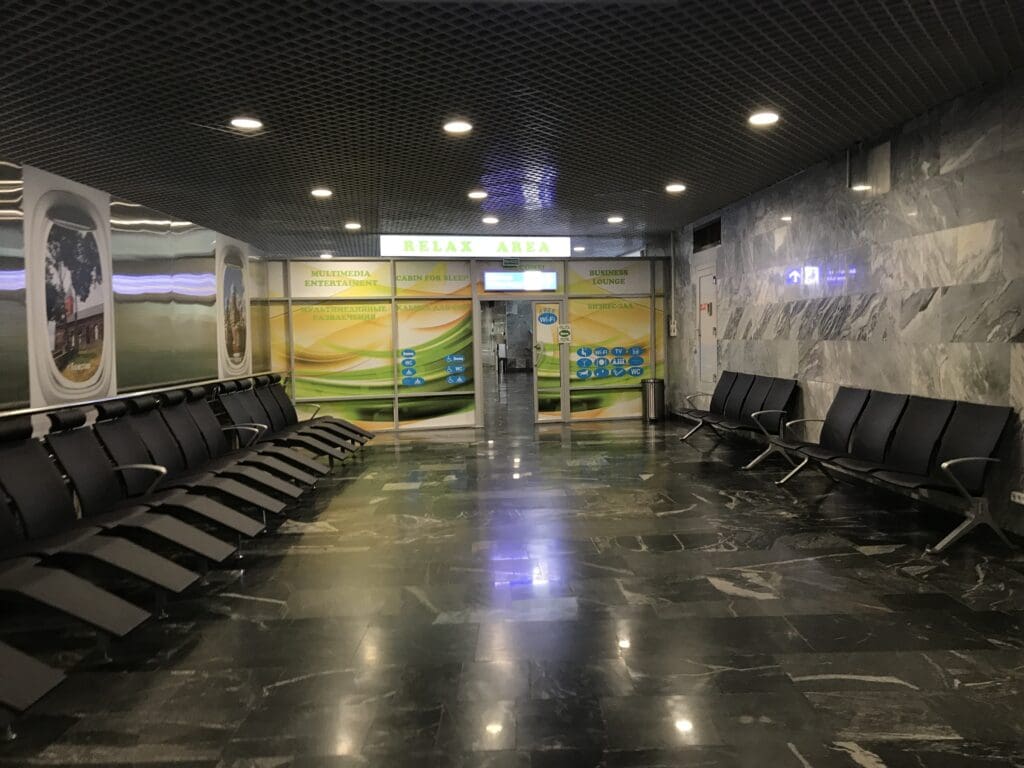
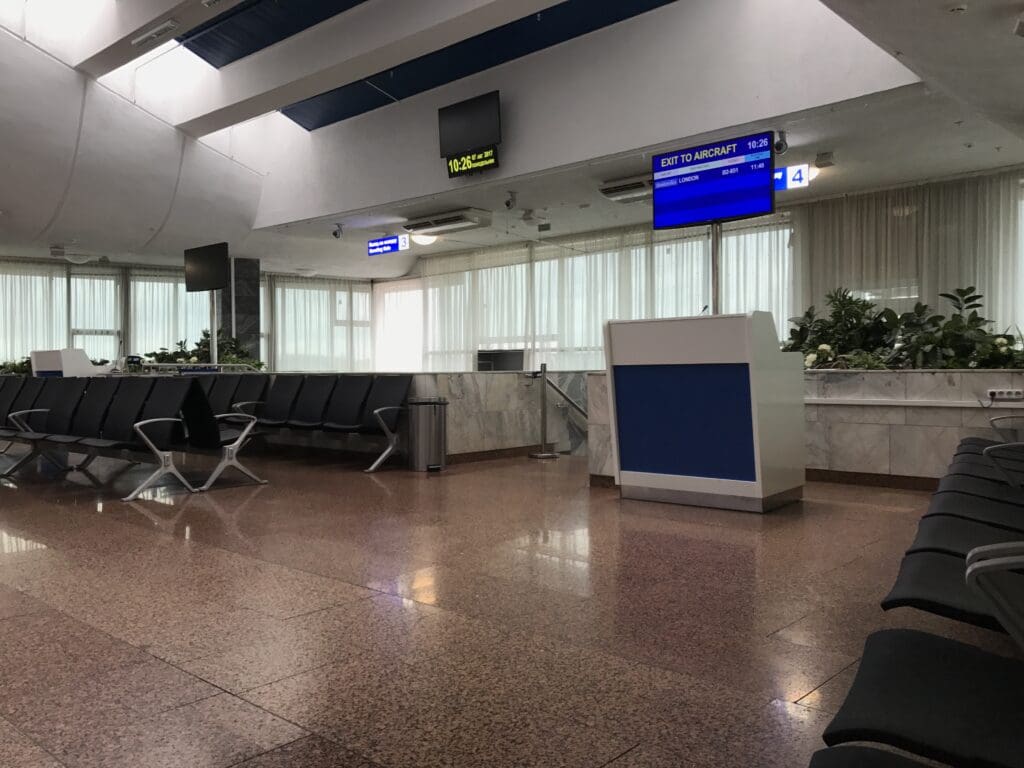
With no departing flights between 1055 and 1200, the airport was understandably quiet with only a fairly small number of passengers milling about at this time. Unsurprisingly, of those flights departing that day, those operated by Belavia dominated the departure boards, with only three flights during my stay operated by other carriers – these operated by Aeroflot, Iraqi Airways and UTair. Whilst Boeing 737 Classics are becoming increasingly rare in Europe, looking outside it was clear that Minsk may well be a contender for the Boeing 737 Classic capital of the continent. On the apro,n a squadron of Boeing 737-300s and Boeing 737-500s could be seen resting between flights. Most of these sported Belavia’s classic blue and white livery although one wore the eye-catching black and orange World of Tanks promotional livery whilst a Boeing 737-500 attempted to hide its age in the Belavia’s recently introduced colour scheme. Aside from these jets, a selection of the airline’s more modern Embraers and Boeing 737-800s could also be seen. Meanwhile, away from the terminal at remote stands, foreign visitors could be seen in the form of a Motor Sich Antonov An-140 which had arrived after a scheduled passenger service from Zaporizhia and a Lithuanian Let 410 operated by Transaviabaltika in an all-cargo configuration. However, undoubtedly the main treasures lay away from the terminal on the far apron, these consisted of a mix of active Ruby Star and Transaviaexport Antonov An-12s, Antonov An-26s and Ilyushin Il-76s as well a sole Boeing 747-300F.
With little to do and attracted by the restaurant’s fast wifi and decent views of the apron, I decided to have an early lunch at the airport’s Burger King. As I ate, a long and thin Belavia Embraer 195 was towed towards the terminal, contrasting with short and stubby Boeing 737-500s that surrounded it. By 1100, a Belavia Boeing 737-500 could be seen being prepped at a remote stand which I worked out was likely to be the aircraft operating the flight over to Gatwick. With half an hour to go until boarding, I decided to have a final wander around the rather unique terminal before heading over to gate 4. Upon arriving here, around thirty or so other passengers could already be seen, however, I assumed that a number of these would be heading onto Odessa with this flight departing from the neighbouring gate.
A few minutes before boarding’s scheduled commencement time, an announcement for the Gatwick flight was made and a long line of passengers suddenly formed. Following the usual shuffling forward, I had my boarding pass scanned before I made my way down the dingy grey marble stairwell and outside onto the waiting bus. After waiting on the bus for around five minutes whilst the ground staff tried to squeeze an entire Boeing 737’s worth of passengers onboard, the doors closed and the bus commenced its short journey over to a Boeing 737-500 wearing Belavia’s classic livery. That morning, EW-290PA, an almost 21-year-old Boeing 737-5Q8 would be operating the service over to Gatwick. Having made its first flight from Renton in November 1996, a month later the aircraft headed down to Brazil to fly with Rio-Sul as PT-SSB. Following the Brazilian carrier’s ceasing of operations in 2002, the aircraft entered long-term storage before heading to cooler climes to fly with Lithuanian Airlines as LY-AZM, with the carrier soon rebranded to flyLAL. In March 2006, the aircraft was leased to short-lived Swedish low-cost carrier FlyMe although following the airline’s bankruptcy the following year, the aircraft returned to Lithuania where it flew for almost a further two years. In January 2009, the aircraft entered storage in Shannon for a month before crossing the Atlantic and spending four months in storage in Florida. After its extended break in the Floridan sunshine, in August 2009 the aircraft was flown across to Minsk where it made its home only 120 miles from its previous base in Vilnius. In the week before my flight, the aircraft had flown over 20,400 miles over 39 flights connecting Minsk with Amsterdam, Kyiv Borispol, Kyiv Zhulyany, Moscow Domodedovo, Moscow Zhukovsky, Palanga, Paris CDG, Prague, Sochi and St Petersburg.
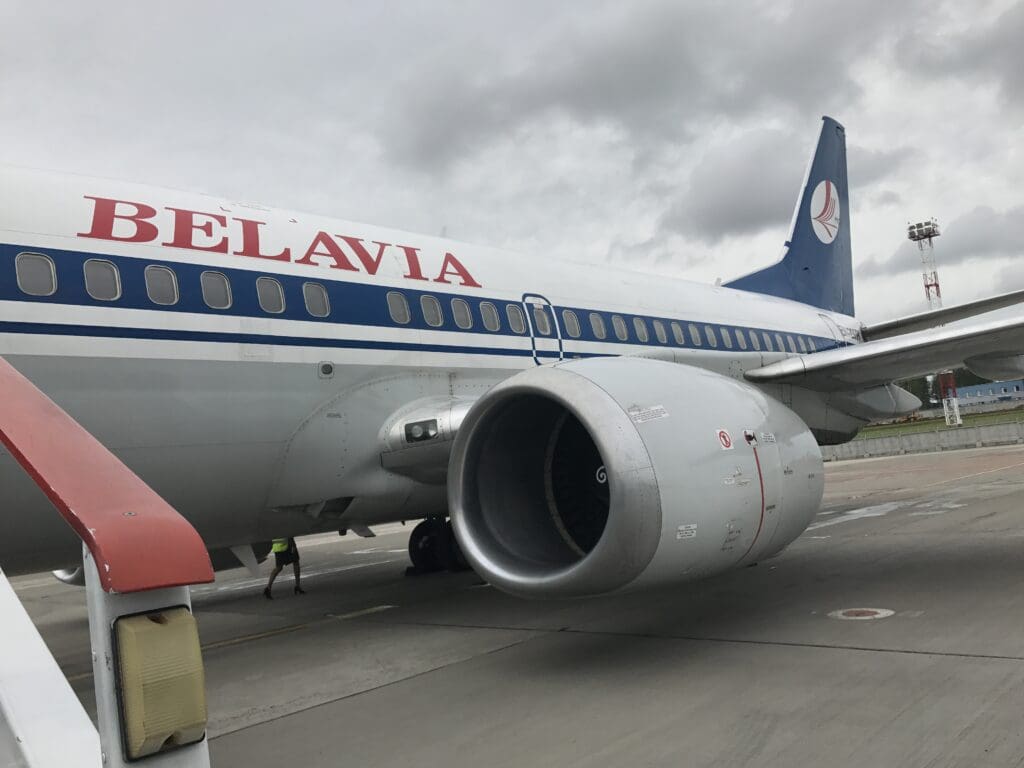
After waiting at the bottom of the airstairs whilst the agent tried to limit the number of people climbing up these at any one time, I climbed these and entered the forward galley. As soon as I stepped aboard I was given a warm greeting by one of the crew members here and turned right into the slightly dated-looking cabin. Unlike the Boeing 737-800 that I had taken earlier that day, this featured a ‘real’ business class cabin consisting of three rows of comfortable looking (faux?) leather seats in a 2-2 configuration. Meanwhile, in Economy, each seat was covered in a blue fabric and complete with a disposable Belavia antimacassar, turning to the armrests these were complete with ashtrays! Upon taking my seat, I concluded that whilst the aircraft’s cabin appeared to be in slightly better shape than the SCAT Airlines Boeing 737-500 I had taken the previous day, thanks to the tight legroom the seat was a little more uncomfortable.
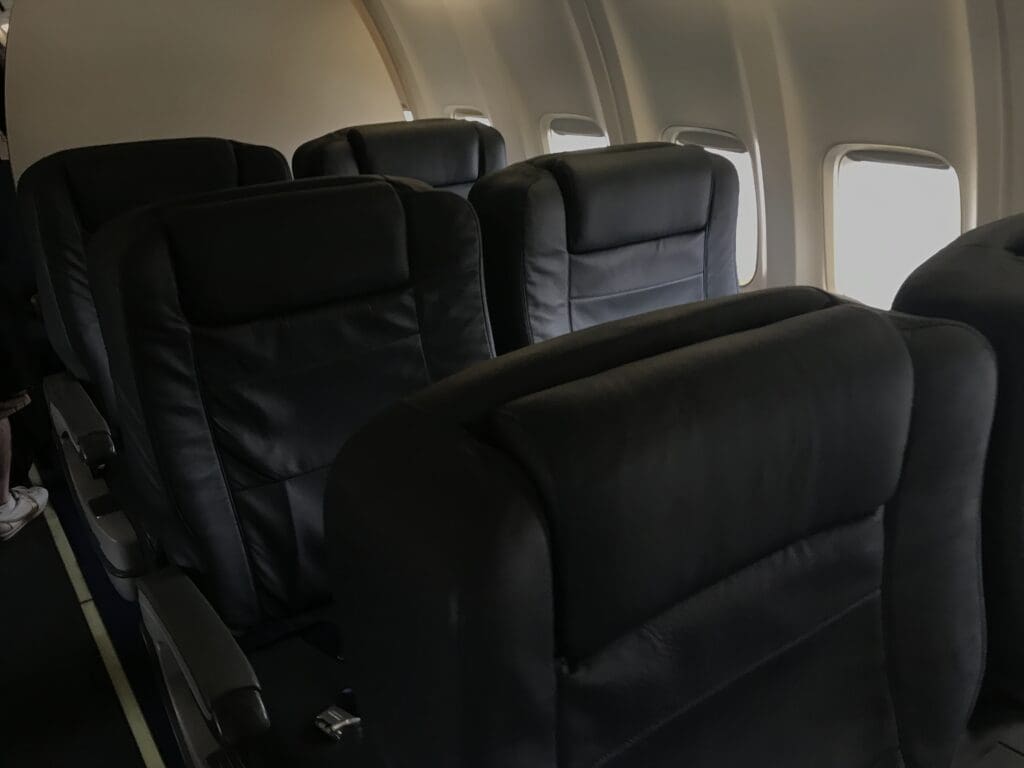
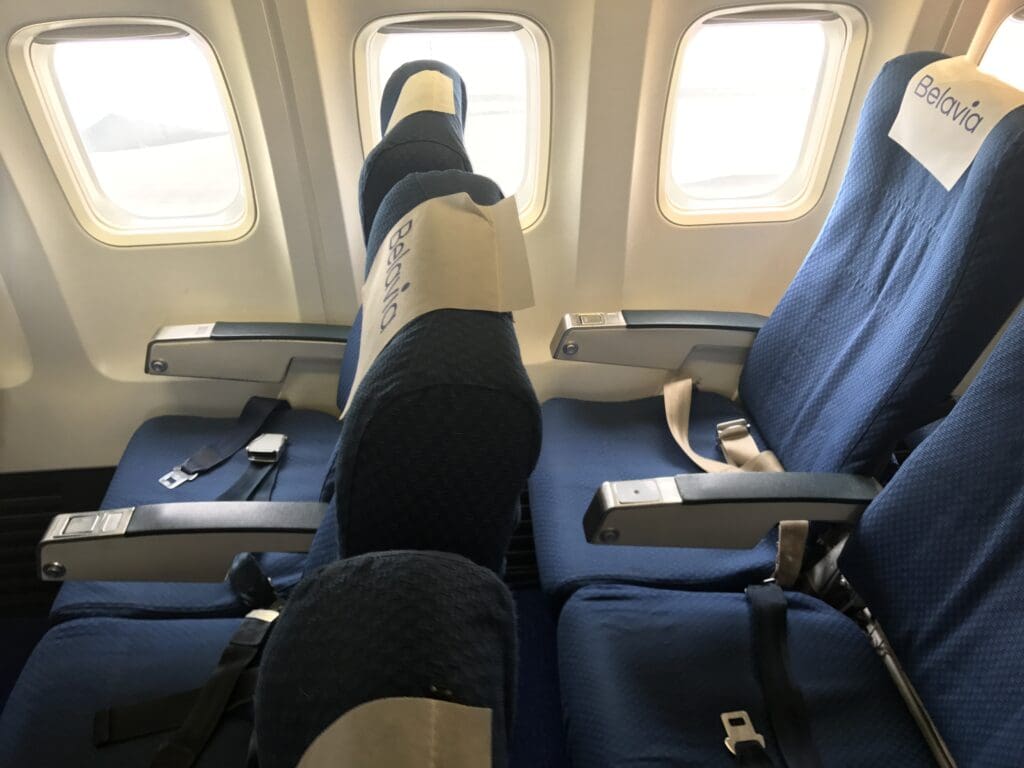
Within a minute of sitting down in my window seat, the two neighbouring seats were soon filled. Travelling as part of a family, my neighbour asked if I could swap seats with his son. Whilst this would mean switching to a middle seat, I felt as if I had no choice but to accept this and so I soon moved over. By 1205 all passengers had made it onto the aircraft and the purser began their usual bilingual welcome speech. Once this had been made, the captain began his quiet welcome announcement which included the usual information about the route, weather and flying time whilst several cabin crew members passed through the cabin handing out boiled sweets. Glancing out of the window, the Boeing 737-800 I had arrived on earlier that morning could be seen pulling up to the neighbouring stand after a morning rotation to Moscow. At 1217, the aircraft’s two CFM56-3C1 engines spooled up as the safety demonstration was performed and around three minutes later the aircraft taxied forward out of the stand under its own steam. From the stand, the aircraft’s journey to the runway took it past the Iraqi Airways Boeing 737-800 preparing to head back to Baghdad as well as a Belavia Embraer 175 before passing a line of interesting Soviet-built cargo aircraft.
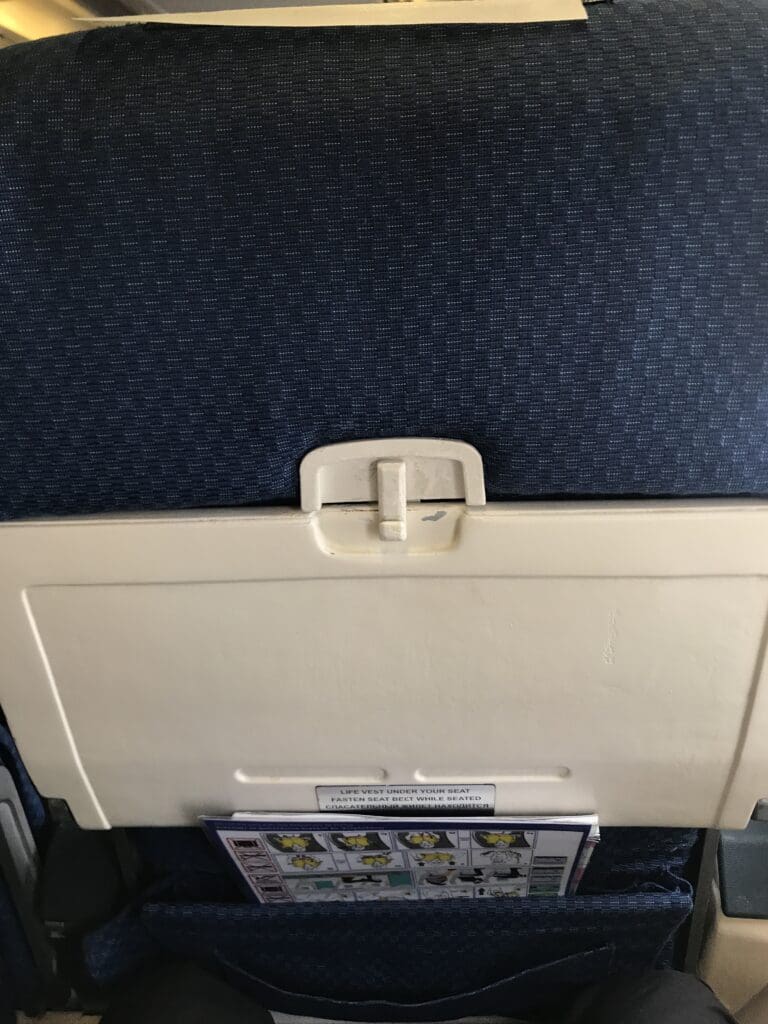
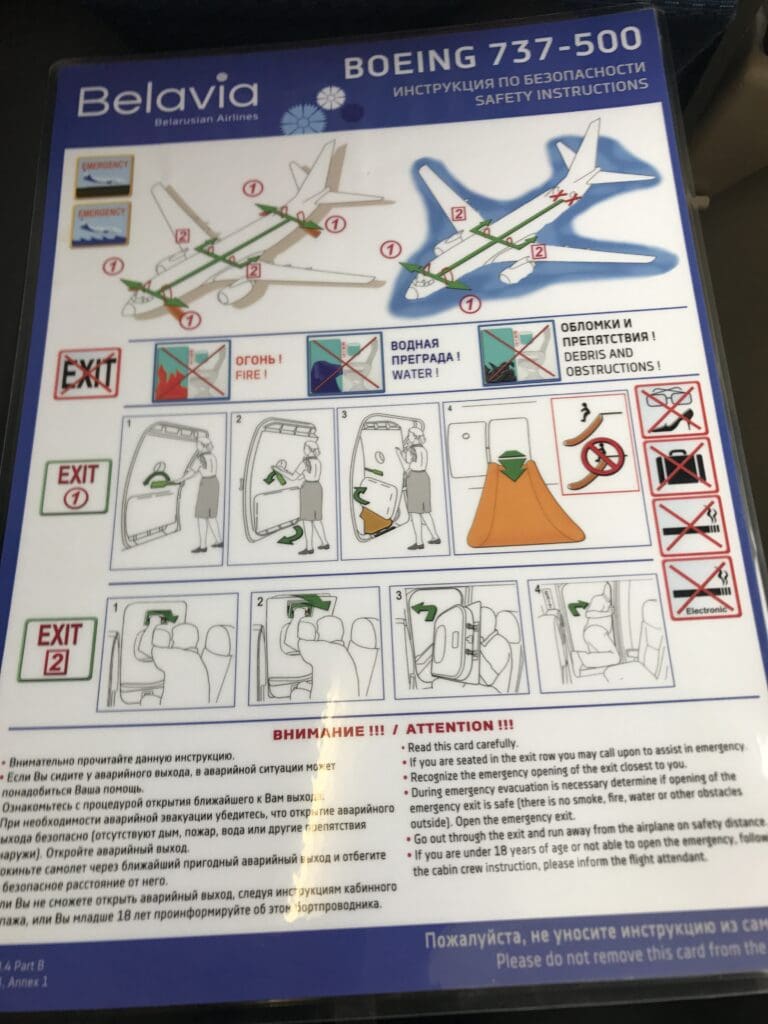
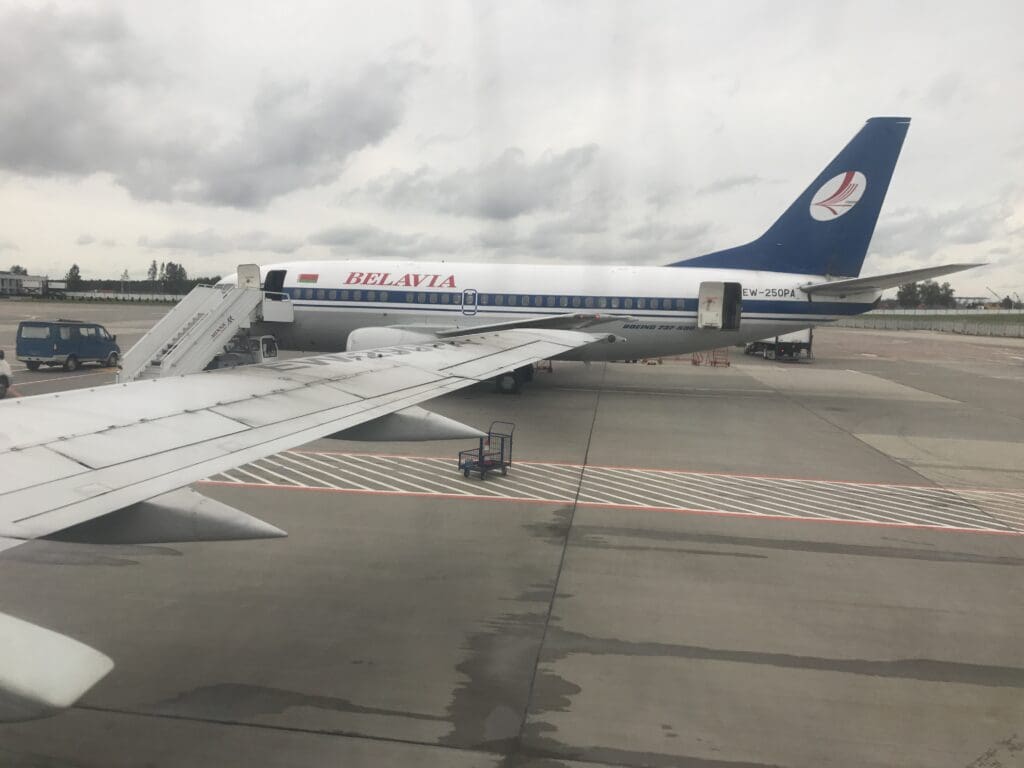
At 1225, the two engines roared into life, powering the aircraft down runway 31 before the jet made a gentle departure and steep climb up into the Belarusian skies. Once the jet climbed above the clouds, the seatbelt signs were switched off and a while later at 1250 the purser announced the commencement of the lunch service. First up was the drinks trolley, and upon reaching my row I opted for a plain and simple apple juice. Around ten minutes later the distribution of meals commenced and, as had been the case on the flight over from Kazakhstan, I was soon handed a Belavia branded box as well as a hot foil dish. Focusing on the former, this contained a feta cheese salad, bread roll with butter and a small bar of dark chocolate whilst the main dish was chicken accompanied by maize and vegetables.
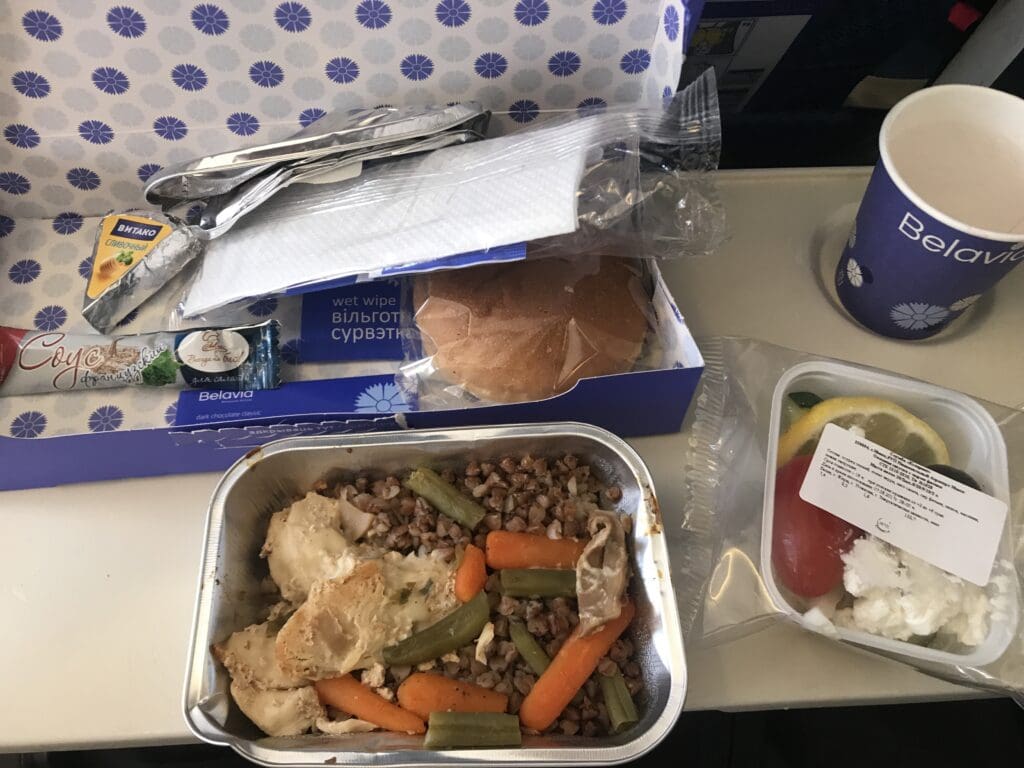
Overall this service was slightly better than on the previous flight although the food was still rather bland. After the remnants of the meal were cleared away the crew came around with UK arrival forms for those without EU passports. After crossing Poland and Germany the aircraft neared the Netherlands and I decided to pay a visit to the rear lavatory. Unlike the SCAT Airlines Boeing 737-500, there was only one toilet at the rear of the aircraft which sat in the cabin as opposed to in the rear galley. Upon entering this, whilst slightly old fashioned I found this to be in a much better condition and far cleaner than the bathroom I had sampled on SCAT Airlines.
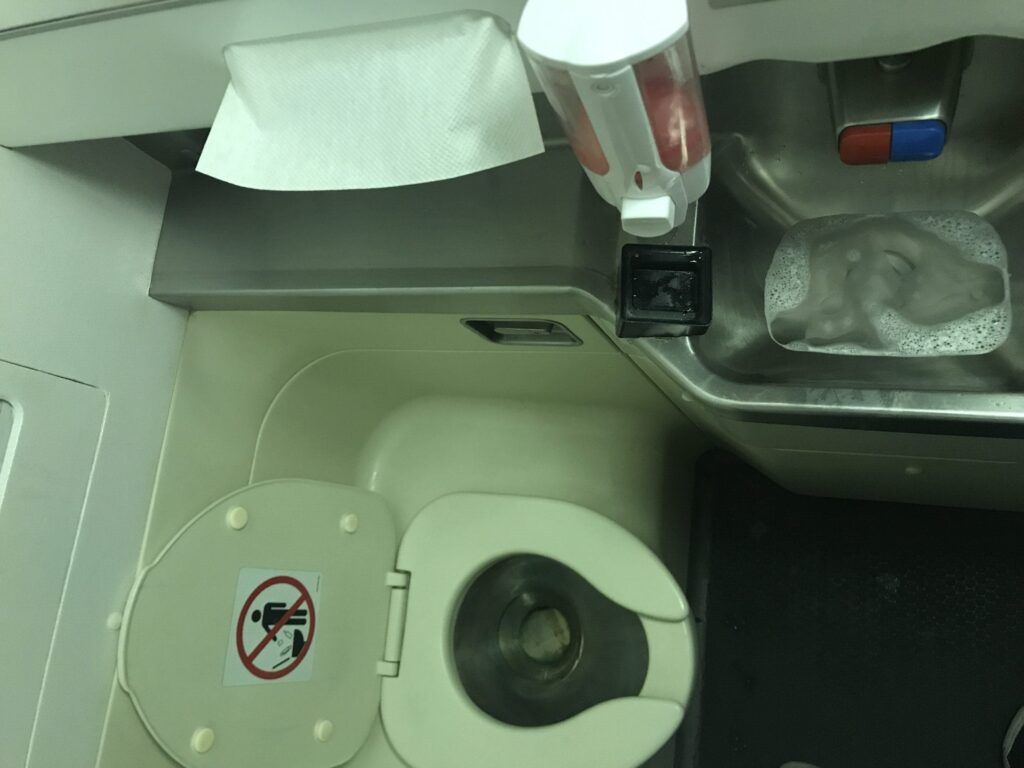
At 1237 UK time, the city of Arnhem appeared indicating the aircraft had entered Dutch airspace and, given the fairly small size of the country, this was crossed from east to west in around twenty minutes. After passing over Rotterdam, the aircraft made its way over the blue waters of the North Sea before pitching downwards indicating the commencement of the aircraft’s descent.
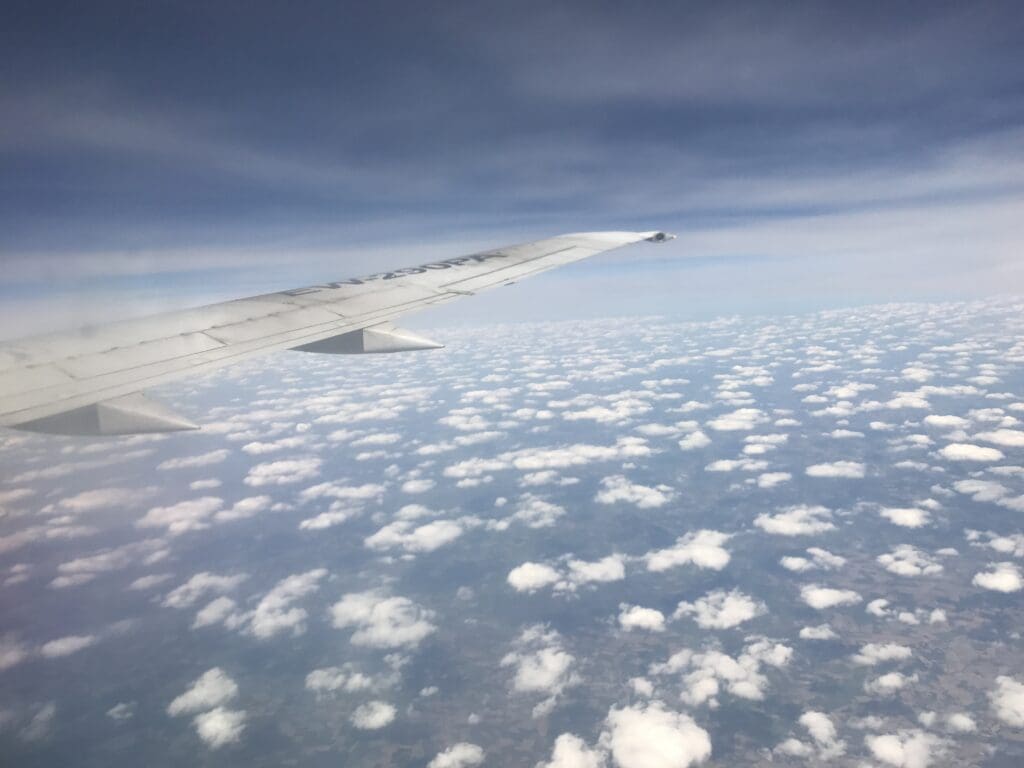
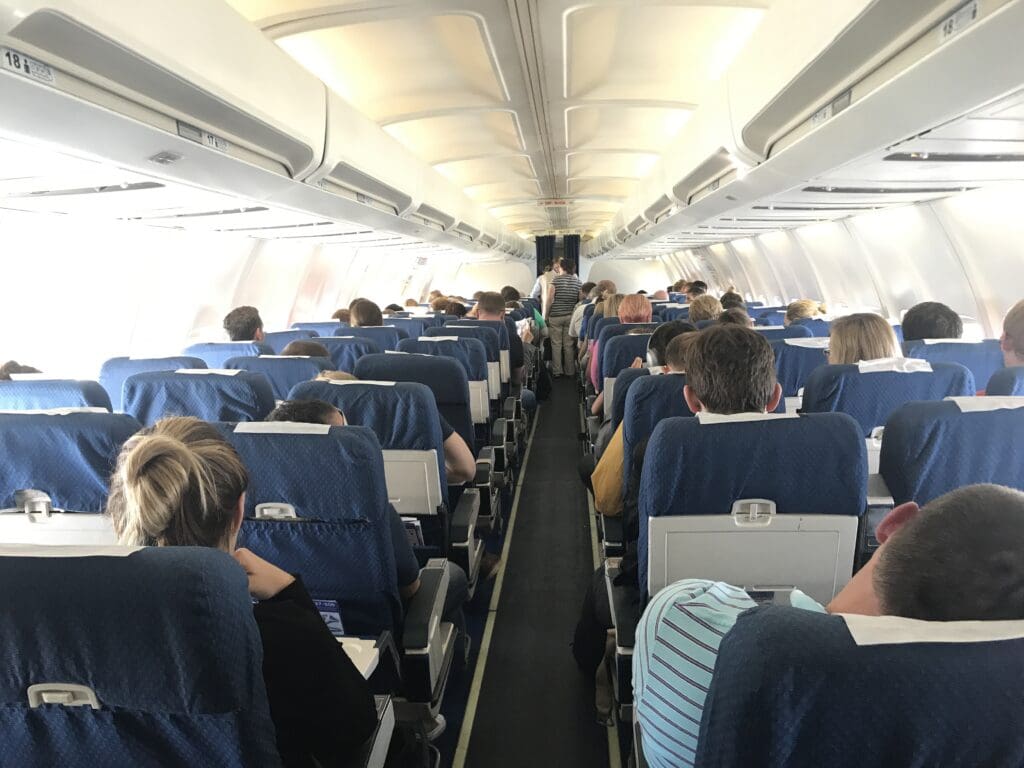
A short time after leaving the Netherlands the aircraft crossed the Kent coast near the seaside town of Margate at an altitude of 14000 feet. From there the jet flew across the country towards the South Coast with Dover Harbour clearly visible before continuing to fly along the long sandy coast until reaching Hastings where the aircraft turned north towards Gatwick. At this point, the seatbelt signs were switched on and the pre-arrival announcement was made informing all onboard that the aircraft would land in ten minutes and the ground temperature was 18 degrees. After popping through the clouds, the green fields of the UK came into view and at 1327 the aircraft made a soft touch-down on Gatwick’s runway 26L which was followed by some very harsh braking and a short taxi over to a gate at the North Terminal.
From the aircraft’s arrival gate, a long walk to immigration was required however once here I was able to enter the UK rather quickly via one of the many immigration e-gates. By the time I reached the baggage collection hall, my suitcase could already be seen spinning around, so I picked it up and walked out to arrivals, ending my long journey from Daegu.
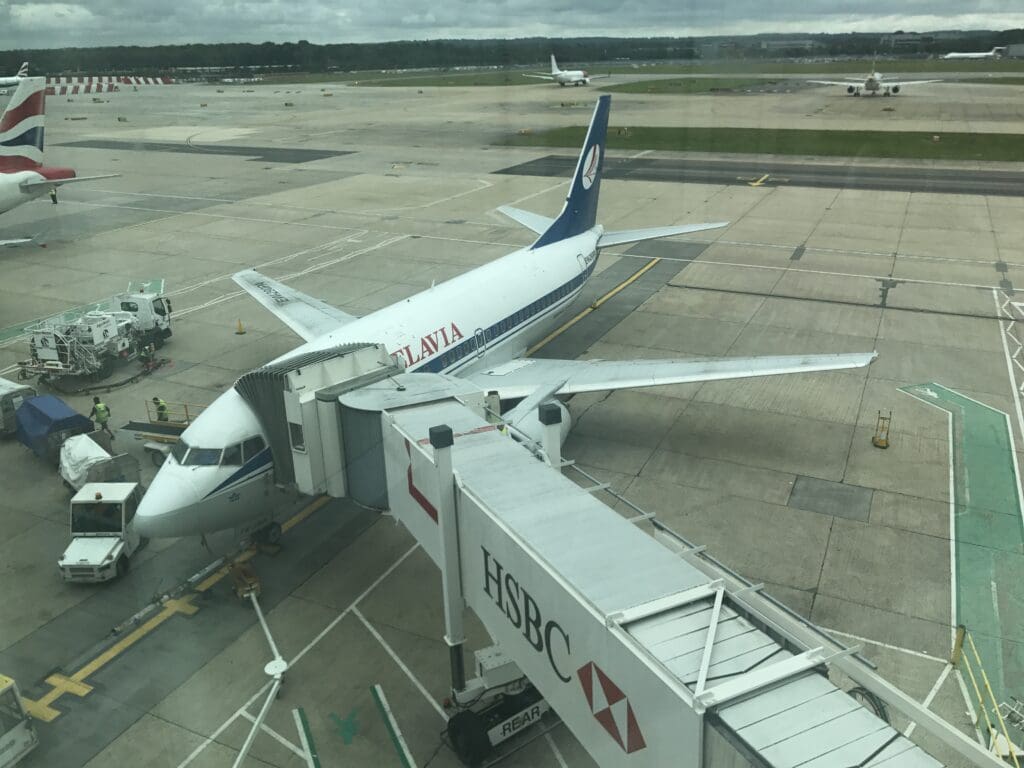
Summary
Whilst I could complain about the tight legroom or the bland food served onboard my two flights, all in all, my experience wasn’t too bad. Focusing on the positives, the Boeing 737-800 was in good condition and appeared to have been cleaned well before my flight, whilst the Boeing 737-500 also appeared to be in decent shape considering the aircraft’s age. On both flights, the crew were friendly enough and appeared to have good levels of English. Meanwhile, transiting in Minsk was easy and the ticket check and security were quick to pass through. All in all, I would probably fly with Belavia again in the future if the opportunity to do so presented itself!

